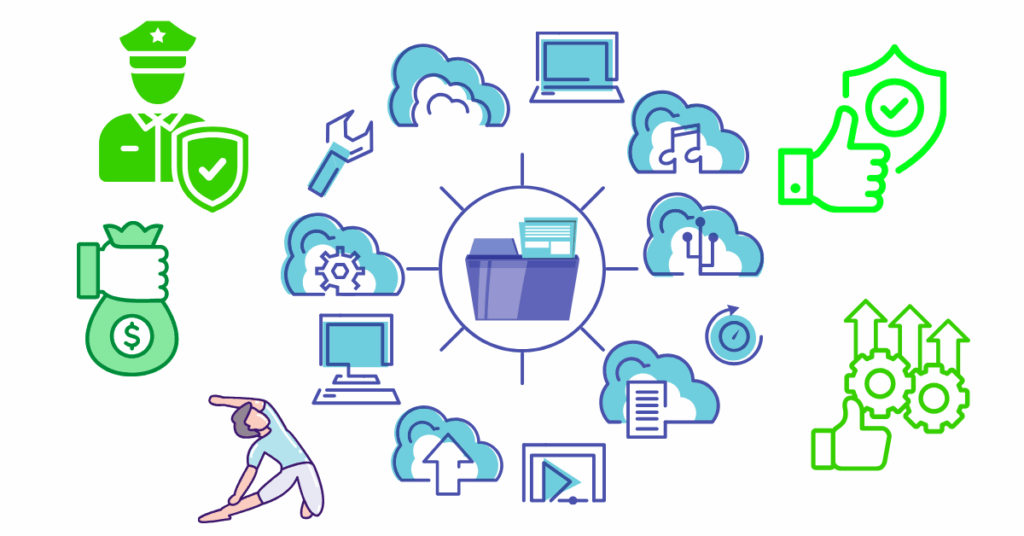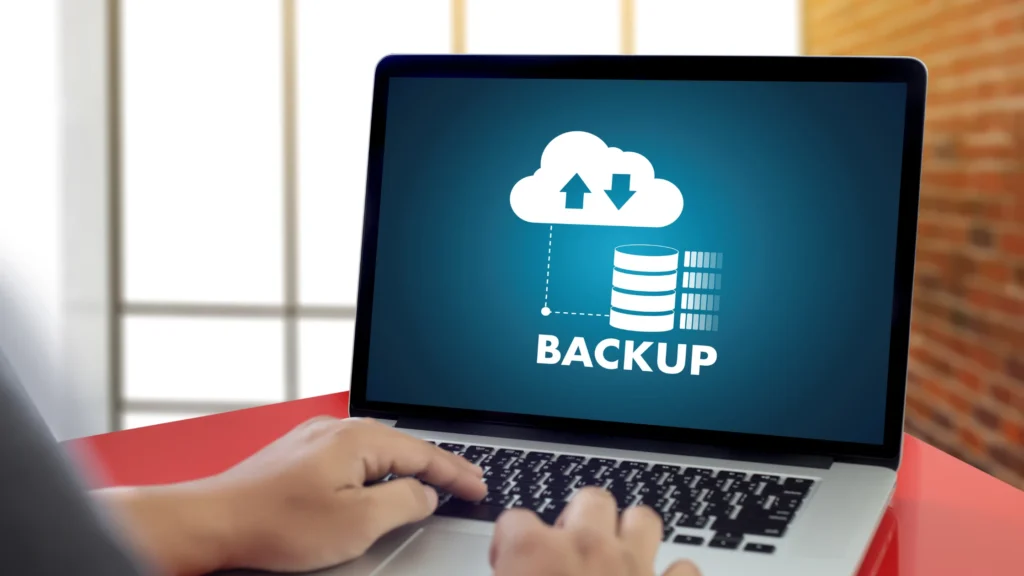Last updated on November 10th, 2025 at 04:58 am
Have you ever heard someone say, “The cloud isn’t safe” or “It costs too much”?
Before you join that group of people who still believe old myths about cloud computing, get the truth. Otherwise, these misconceptions about cloud computing will stop you from using tools that make your work faster, cheaper, and more secure.
Cloud computing powers the world’s biggest apps, stores your favorite photos, and runs tools your business may already use every day, from email to file sharing. Yet, myths can stop you from using it fully.
It’s a simple idea.
Your files, apps, and tools live on servers connected through the internet, not locked in one computer or office.
Still, the confusion comes from years of mixed messages and marketing buzzwords. Many think it’s expensive, unsafe, or only for tech giants.
In this guide, we’ll go step by step to debunk the 8 biggest cloud myths and show what’s actually true.
Let’s clear up the noise and get to the truth on common myths about cloud computing.
Myth #1: Cloud Computing Isn’t Secure

This is one of the most common myths about cloud computing, and it’s easy to see why. The idea of your files being stored somewhere you can’t see feels risky.
But here’s what’s real: cloud security today is stronger than most on-site systems.
Providers such as CloudPap and Amazon Web Services (AWS) use encryption, firewalls, and constant monitoring to protect information. Data is often stored in multiple data center regions, so if one fails, another instantly takes over.
Cloud security works under a shared responsibility model. The provider secures the infrastructure, and the user secures their accounts and settings.
For example, Amazon Web Services and Google Cloud both encrypt data at rest and in transit. That means your files are scrambled into unreadable form unless you have the right key.
Even regulated industries like healthcare and banking use the cloud while meeting GDPR and HIPAA standards.
Myth #2: The Cloud Costs More Than On-Premises
This one sounds believable until you look at the math.
Yes, you pay monthly for cloud resources. But you only pay for what you use. That’s the pay-as-you-go model, which means zero waste.
Compare that with on-premise setups:
- You buy servers up front.
- You pay for power, cooling, and maintenance.
- You still pay even when those servers sit idle.
Cloud hosting changes that.
You can scale resources up or down instantly. That makes the total cost of ownership (TCO) far lower over time.
Small and large businesses now use resource optimization tools to track cost and performance. These tools automatically shut down unused resources. Something traditional setups can’t do.
So, the myth that “cloud is too expensive” misses the bigger point. The cost model is flexible.
You control how much you spend and when.
Myth #3: Cloud Computing Means Losing Control
Some believe that if your data lives elsewhere, you lose power over it. Cloud hosting gives you more control, not less.
You can manage everything through dashboards, from user access to live performance monitoring.
Automation tools let you deploy, pause, or scale workloads whenever you want.
Through cloud governance policies, you can set permissions so that only specific people can access sensitive areas.
If someone leaves your team, you can instantly revoke access. That’s harder to do with local servers sitting in one room.
Cloud providers also back their service with Service Level Agreements (SLAs) promising uptime.
For example, most guarantee 99.95% or higher uptime. That’s less than 22 minutes of downtime a month.
So, you’re not losing control; you’re just gaining smarter tools to manage it better.
Myth #4: The Cloud Is Just for Big Companies
Here’s one of the oldest myths about cloud computing, and it couldn’t be more wrong.
Cloud computing was built to scale. That means small businesses and startups can use the same power as big enterprises, but at their own size and budget.
If your online store grows fast during the holidays, cloud systems automatically scale resources.
When sales slow, it scales down—no wasted money.
Even freelancers and small agencies use hybrid cloud models (a mix of public and private clouds) to balance flexibility with cost.
So, whether you’re a one-person shop or a global brand, the cloud fits your level. That’s the beauty of scalability and elasticity.
Myth #5: Migration Is Too Complicated

Moving to the cloud can sound scary. Terms like “migration strategy,” “testing,” and “downtime” make it feel like a tech nightmare.
But modern cloud migration is faster and simpler than ever.
Cloud hosting providers now offer managed migration services that guide you through every step, from assessing workloads to testing performance before you go live.
A typical website migration involves
- Reviewing your current setup
- Picking workloads to move
- Testing in a small environment
- Moving the rest when ready
You can migrate in stages, not all at once.
Automation also helps detect errors before they cause downtime.
So no, migration isn’t too hard. With a plan and the right provider, it’s smoother than most software updates.
Myth #6: Vendor Lock-In Makes It Risky
This cloud computing myth has some truth to it. But not how people think.
Vendor lock-in used to be a big issue. Once you picked a provider, moving data elsewhere was a headache.
Today, multi-cloud strategies and containerization tools like Kubernetes make it easy to switch.
You can run apps in one provider today and move them tomorrow if costs or features change.
APIs, open-source platforms, and portability standards allow this freedom.
So while you should plan for flexibility early, modern cloud tech makes it simple to diversify and integrate across systems.
You can even spread workloads across AWS, Azure, and Google Cloud for balance.
The best strategy is to design your system so it’s cloud-agnostic (able to work anywhere).
Myth #7: The Cloud Isn’t Reliable Enough
Reliability is one of the cloud’s strongest points.
Every major provider, such as CloudPap, spreads data across availability zones—multiple data centers in different regions.
If one server or zone fails, another takes over instantly. This setup guarantees constant uptime and data safety.
Most providers publish their SLA commitments publicly. CloudPap, AWS, Azure, and Google Cloud all promise at least 99.99% uptime for their services. That’s about 4 minutes of downtime a month. Far better than most on-premise setups.
Cloud providers also run real-time monitoring, backups, and automated failovers.
This means no manual rebooting or waiting for someone to fix a local server in your office.
In short, the cloud is not only reliable, it’s built to stay online no matter what.
Myth #8: Cloud Computing Is Bad for the Environment
It’s easy to assume that massive data centers harm the planet. But the reality is different.
Cloud infrastructure is actually more energy-efficient than traditional setups.
Here’s why:
- Cloud data centers share resources across many users, reducing waste.
- They use renewable energy and advanced cooling systems to cut power use.
- Centralized designs let engineers optimize servers for lower carbon footprints.
So when businesses move to the cloud, they often lower both their energy bills and their environmental impact.
What’s Actually True About Cloud Computing

After debunking the myths about cloud computing, let’s talk about what’s actually true.
Cloud computing helps businesses become faster, safer, and more cost-effective, which is why many are moving to the cloud.
It gives teams instant access to apps, data, and tools. From anywhere, on any device.
When used wisely, the cloud improves:
- Performance through global data centers
- Security through encryption and monitoring
- Flexibility through scalable resources
- Savings through pay-as-you-go pricing
- Reliability through redundancy and uptime guarantees
These aren’t claims. They’re proven by years of data and real-world results.
The lesson?
Stop believing the hype.
The cloud is not a luxury or a risk. It’s the future of how we store, manage, and build digital tools.
Stop Believing the Hype, Start Using the Cloud Smartly
By now, you’ve seen that most fears about the cloud are myths.
Cloud hosting security is stronger than ever. Costs are flexible. Control is in your hands. And it’s not just for big companies. Cloud is for everyone ready to grow smarter.
Cloud computing is the backbone of today’s digital world. Whether you’re a business owner, developer, or freelancer, using the cloud wisely gives you speed, savings, and peace of mind.
If you’re ready to explore real, reliable, and affordable cloud hosting, start with CloudPap. We’re a trusted platform built for performance, uptime, and simplicity.
Your journey to smarter cloud use begins there.

